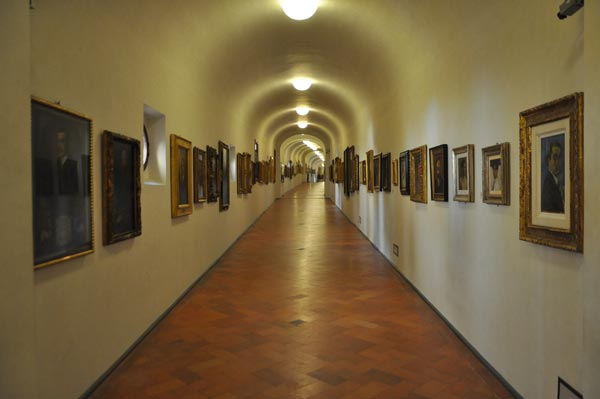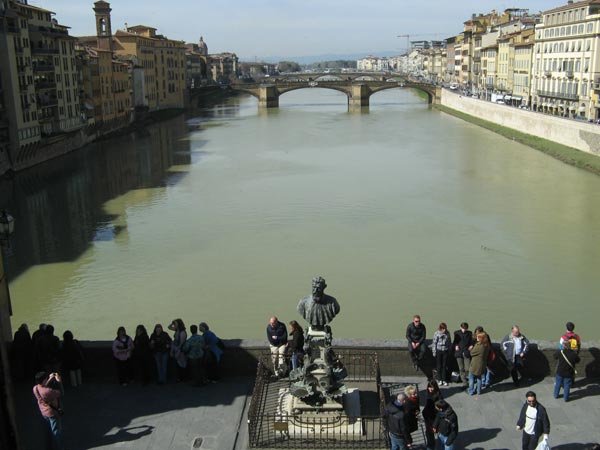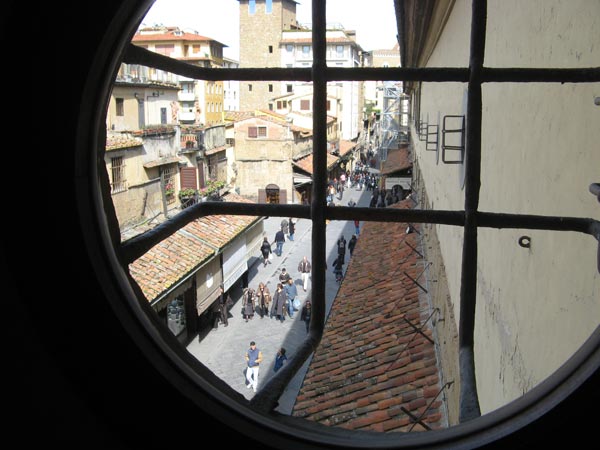Plans for the Vasari Corridor
2016

New director for the Galleries of the Uffizi, Eike Schmidt, has offered remarks on his proposed plans for opening the Vasari Corridor to the general public and moving the self-portrait collection from the Corridor, in order to answer doubts raised about the plans for the Vasari Corridor.
First, you should know that the Vasari Corridor, the 16th century elevated and enclosed hallway that connects the Uffizi Gallery to Palazzo Pitti, is generally closed to the public. There were a few special openings a few years ago offered by the museum, and these were sold out in a matter of weeks. So the interest to visit the Corridor has been, and remains, high and this is likely because it is generally closed so a visit seems to be special.
The Corridor hosts one of the largest and oldest collection of self-portraits of artists from the past centuries. The proposal would be to move it into the Uffizi Gallery.

The museum today only opens the Vasari Corridor to tour operators and travel agencies who organized the groups and requests “a special opening” of the corridor. The groups are limited to a maximum of 25 people given the width of the Corridor and the necessity of having museum personnel accompany each group. This has allowed the Corridor to be visited, making the visit quite “exclusive” for those who have planned it into their visits to Florence.
Schmidt’s proposed plans would be to eliminate this privilege, offering a Vasari Corridor tour from the Uffizi Gallery to the Pitti Palace with its own entrance ticket (separate from the Uffizi) at an affordable cost (the visit with tour agencies starts at 45 euro and up per person).
There are some organizational problems to deal with: the tour is one-way, so what if you leave a backpack or umbrella checked at the cloakroom at the Uffizi? You can’t get back in to the museum to retrieve them, so Schmidt proposes that as long visitors are advised of this ahead of time, they will know to not bring along any backpacks or umbrellas that need to be checked in and thus eliminate the concern completely.

Others have raised the question of foot traffic: Schmidt says “to remain calm: during the time it takes to cross the Corridor, about a kilometer long, the impact of the weight of the group is never concentrated in one point as is the case, for example, in the Botticelli Hall within the Uffizi Gallery, where groups collect and remain for a while.”
What about the self-portrait collection? First of all, Schmidt reminds all of us, the self-portrait collection was placed along the Corridor only in modern times. The collection, started by Cardinal Leopold de’ Medici was always kept within the Uffizi, in the “Hall of Painters” (the current hall 35 that is dedicated to Michelangelo). This hall was taken apart in the 19th century and the collection kept in the deposits until 1973, when the then-director of the Uffizi Luciano Berti placed it the Vasari Corridor. So its rightful place, actually, would be for it to return within the Uffizi Gallery.
In addition, Schmidt adds, the tour from the Uffizi to the Pitti is generally completed in about 45 minutes so “almost at a run”. It is hardly possible to stop and really admire the collection, other than to stop in front of some of the more celebrated works of art. Within the Uffizi, visitors will be able to admire them with calm. Where they will be placed is yet to be determined.

The biggest concern motivating the move of the collection is actually the most important, in my opinion. The Vasari Corridor was not made and is not furnished with any temperature control system. It is exposed to the sun and wind and thus experiences extreme hot and cold through the seasons. This environment is NOT adequate to conserve centuries old paintings made on canvas and wood. The proposal of installing a temperature-control system is also impractical, as it would mean altering the historical architectural structure of the Corridor.
The proposal would be to place within works made out of materials that would withstand, by their very nature, the atmosphere of the Corridor, such as the frescoes detached from the outside of the Corridor itself and which have been in the gallery’s deposits for decades.
At this point, a last change would be to update the type of lighting within to make it more pleasant and adequate for the space. At the very end of “this profound change, the Vasari Corridor will be anything but a highway”, as some have criticized. Above all, the “Prince’s Route” will remain a privileged path given the unique view it offers on the city, the hills and the river but it will finally be open to the public following the spirit of the inheritance Anna Maria Luisa de’ Medici left to the city: the Medici collections left to the city “as an ornament of the State, for the Public Good and to attract the curiosity of Foreigners”.
We applaud Director Schmidt’s plans and remarks on the plans for the future of the Vasari Corridor. We hope that all of these changes are made in the shortest time possible so that the Corridor can be open to all soon.











